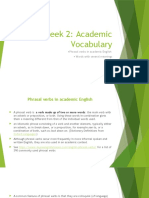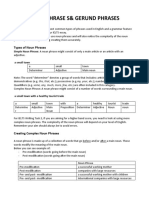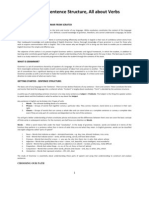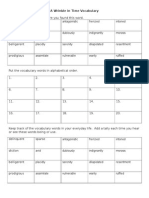Cohesion
Cohesion
Uploaded by
Rosanna BellaubiCopyright:
Available Formats
Cohesion
Cohesion
Uploaded by
Rosanna BellaubiOriginal Description:
Copyright
Available Formats
Share this document
Did you find this document useful?
Is this content inappropriate?
Copyright:
Available Formats
Cohesion
Cohesion
Uploaded by
Rosanna BellaubiCopyright:
Available Formats
Cohesion in Writing
Creating cohesion means ‘tying’ our words, phrases, sentences and paragraphs together, to create a
text where the relationships between these elements is clear and logical to the reader, giving the text
‘flow’. We create cohesion at all these levels (word, phrase, sentence and paragraph), in order to
direct our readers’ attention to the development of our argument. Following are some of the
cohesive tools you can make use of.
Repetition: use a particular word or phrase across different sentences or paragraphs,
e.g. Of course, materials development or adaptation is not the only priority for the professions in
South Africa. However, the focus on materials development is appealing because it provides a very
tangible and practical focus for speech and language therapists (Pascoe et al., 2013).
Synonyms: use a word or phrase in a later sentence which has the same or similar meaning to a
keyword in the first sentence,
e.g. The purpose of population genetics is to quantify and explain the processes generating variation
in natural populations (Vargo & Husseneder, 2011). Sociogenetic studies of eusocial insects are
generally based on the approach that the colony functions as a discrete entity within the population
(Thorne et al., 1999).
Pronouns: use a pronoun to refer back to a phrase already used,
e.g. When scientific experiments do not work out as expected, they are often considered failures until
some other scientist tries them again. Those that work out better the second time around are the
ones that promise the most rewards.
Cohesive Words and Phrases
1. Additive words
Also, and, as well as, at the same time as, besides, equally important, further, furthermore, in
addition, likewise, moreover, too, not only... but also.
2. Amplification words
As, for example, for instance, in fact, specifically, such as, that is, to illustrate
3. Repetitive words
Again, in other words, that is, to repeat
4. Contrast words
But, conversely, despite, even though, however, in contrast, notwithstanding, on the one hand /
on the other hand, still, although, though, whereas, yet, nevertheless, on the contrary, in spite of
this
5. Cause and effect words
Accordingly, as a result, because, consequently, for this reason, since, as, so, then, therefore, thus
6. Qualifying words
Although, if, even, therefore, unless
7. Example
For example, for instance
8. Emphasising words
Above all, more/most importantly
9. Reason words
For this reason, owing to this, therefore
10. Order words
Afterwards, at the same time, before, firstly/secondly, formerly, lastly, finally, later, meanwhile,
next, now, presently, today/yesterday/last week/next year, subsequently, then, until, ultimately,
while, historically, in the end, eventually
11. Explanation
In other words, that is to say
12. Attitude
Naturally, of course, certainly, strangely enough, surprisingly, fortunately, unfortunately,
admittedly, undoubtedly
13. Summary
Finally, in conclusion, in short, to summarise
Remember: Cohesive writing refers to the connection of your ideas both at the sentence level and at
the paragraph level. Cohesion is a very important aspect of academic writing, because it affects the
tone of your writing. Here are some examples that illustrate the importance of connecting your ideas
more effectively in writing:
The hotel is famous. It is one of the most well-known hotels in the country. The latest international
dancing competition was held at the hotel. The hotel spent a lot of money to advertise the event.
Because the hotel wanted to gain international reputation. But not many people attended the
event. (The connection of ideas is not very good.)
The hotel, which is one of the most well-known hotels in this region, wanted to promote its image
around the world by hosting the latest international dancing competition. Although the event was
widely advertised, not many people participated in the competition. (The connection of ideas is
better than in the first example.)
The latest international dancing competition was held at the hotel, which is one of the most well-
known hotels in this region. The hotel spent a lot of money on advertising the event since it wanted
to enhance its international reputation; however, it failed to attract many people. (The connection of
ideas is better than in the first example.)
Adapted from: Young-Kyung Min, 2015. Coherence and cohesion. [ONLINE] Available at:
http://www.bothell.washington.edu/wacc/for-students/eslhandbook/coherence
Compiled by: Karis Moxley, 2015.
You might also like
- 2nd Generation of Filipino ArchitectsDocument14 pages2nd Generation of Filipino ArchitectsJAXXNo ratings yet
- Selecting and Organizing Info.Document2 pagesSelecting and Organizing Info.Char LayiNo ratings yet
- Lesson 1 RwsDocument5 pagesLesson 1 RwsMark Steven TalagNo ratings yet
- Last Lesson g10Document96 pagesLast Lesson g10xqv5gcgydnNo ratings yet
- WT2 CutDocument71 pagesWT2 Cutmurodovazizbek709No ratings yet
- Writing Task 02Document70 pagesWriting Task 02Jesús Flores HernándezNo ratings yet
- TRANSITIONAL DE-WPS OfficeDocument14 pagesTRANSITIONAL DE-WPS Officemaahiaqsa91No ratings yet
- GNS201 CourseDocument24 pagesGNS201 Courseibiwoyeabisola0No ratings yet
- Week 2 GrammarDocument22 pagesWeek 2 GrammarJoseph DillinghamNo ratings yet
- Linking WordsDocument11 pagesLinking Wordsrajanraj0534No ratings yet
- Grammar Spell PunctDocument18 pagesGrammar Spell PunctReka KutasiNo ratings yet
- Logical Connectors: Unexpected Result), ConditionDocument12 pagesLogical Connectors: Unexpected Result), ConditionRocelene Veraann RukiminNo ratings yet
- Grammar and StyleDocument5 pagesGrammar and StyleoscarvanquelloNo ratings yet
- Unit 1-Lesson 4 (Properties of A Well-Written Text)Document50 pagesUnit 1-Lesson 4 (Properties of A Well-Written Text)Lennie Diaz60% (5)
- Lesson 1 - Sentence Unity and Coherence: (Wrong Because of Shift of Subject From Student To Project)Document4 pagesLesson 1 - Sentence Unity and Coherence: (Wrong Because of Shift of Subject From Student To Project)Jamie MedallaNo ratings yet
- Academic English: COM 107-M11267 COM107-M11335 COM 107-M11278Document11 pagesAcademic English: COM 107-M11267 COM107-M11335 COM 107-M11278Prem LokwaniNo ratings yet
- English I (SAO)Document12 pagesEnglish I (SAO)Roberto MatusNo ratings yet
- Cohesive Elements: 1. Use of Correct PunctuationDocument2 pagesCohesive Elements: 1. Use of Correct PunctuationAndres NavarroNo ratings yet
- CORE 001 3rd Quarter - Lesson 4Document13 pagesCORE 001 3rd Quarter - Lesson 4NatsumiGraceNo ratings yet
- Reading and Writing Q1M3Document10 pagesReading and Writing Q1M3inamowtoNo ratings yet
- QUESTIONSSSDocument6 pagesQUESTIONSSSAlexaNo ratings yet
- Coherence and CohesionDocument8 pagesCoherence and Cohesionzahraawb123No ratings yet
- Presenting A Coherent, Comprehensive Report On Differing ViewpointsDocument35 pagesPresenting A Coherent, Comprehensive Report On Differing ViewpointsYsabel PeridoNo ratings yet
- Presenting Coherent ViewpointDocument34 pagesPresenting Coherent Viewpointjoanne.magbitang13No ratings yet
- List of Transition WordsDocument16 pagesList of Transition WordsLeninNo ratings yet
- Lecture 01 (Vocabulary Building)Document27 pagesLecture 01 (Vocabulary Building)Saira KousarNo ratings yet
- RPP IhdDocument8 pagesRPP IhdmeymirahNo ratings yet
- Lesson 1: Context Clues: Transitional MarkersDocument9 pagesLesson 1: Context Clues: Transitional Markersronnie yagoNo ratings yet
- Lưu Ý VOCABDocument11 pagesLưu Ý VOCABvipikonic09No ratings yet
- Cl106 Reading Skills 2 - 1-1Document49 pagesCl106 Reading Skills 2 - 1-1Mo Blaced UlrickNo ratings yet
- Cohesion & CoherenceDocument20 pagesCohesion & CoherenceMuhammad Ali Kausar100% (1)
- Verb Tense Used in Literature ReviewDocument4 pagesVerb Tense Used in Literature Reviewfvgh9ept100% (1)
- Sixty Words or Phrases Commonly Misused by ESL/EFL Students Preparing for UniversitiesFrom EverandSixty Words or Phrases Commonly Misused by ESL/EFL Students Preparing for UniversitiesRating: 2.5 out of 5 stars2.5/5 (7)
- The Mechanics of Writing: The Various Parts of Speech and How They Function TogetherDocument5 pagesThe Mechanics of Writing: The Various Parts of Speech and How They Function Togethersangeetha_balasubramNo ratings yet
- Transition WordsDocument6 pagesTransition Wordspeiling87100% (1)
- Session 4 - Group 3Document10 pagesSession 4 - Group 3KaislaNo ratings yet
- Coherence in WritingDocument3 pagesCoherence in WritingScha Wan Md SukriNo ratings yet
- Writing Trasition Words For EssayDocument6 pagesWriting Trasition Words For EssayManjunathBVenkateshNo ratings yet
- Noun Phrase SDocument8 pagesNoun Phrase SBuiloan1986No ratings yet
- RWS Module 2 Lessons 1 3 1Document8 pagesRWS Module 2 Lessons 1 3 1jy6fybjr5bNo ratings yet
- Module 31 Improving Your EssayDocument5 pagesModule 31 Improving Your EssayddddddaaaaeeeeNo ratings yet
- Module 2Document14 pagesModule 2Monnay MousNo ratings yet
- Basic EnglishDocument41 pagesBasic EnglishMuhammad Mubeen Iqbal PuriNo ratings yet
- Coherence: Repetition of A Key Term or PhraseDocument10 pagesCoherence: Repetition of A Key Term or PhraseHoanglinh TranNo ratings yet
- Final Assignment Module 6Document10 pagesFinal Assignment Module 6EkoNo ratings yet
- Features of Academic WritingDocument33 pagesFeatures of Academic WritingEamannie Rose OstanNo ratings yet
- EXAM 2022 Cognitive Science LinguisticsDocument8 pagesEXAM 2022 Cognitive Science Linguisticsanna.kowalskaNo ratings yet
- Unit1 Notes (1) BAS 205Document11 pagesUnit1 Notes (1) BAS 205vc323750No ratings yet
- English ConnectorsDocument50 pagesEnglish ConnectorsJuan Carlos Rodriguez100% (1)
- Transition 2Document3 pagesTransition 2katak kembungNo ratings yet
- Term Paper MorphologyDocument8 pagesTerm Paper MorphologyPayingSomeoneToWriteAPaperSingapore100% (1)
- Week 3 - Writing Materials 3 - Sentence and Parapgraph-Level Paraphrasing Pack For StudentsDocument15 pagesWeek 3 - Writing Materials 3 - Sentence and Parapgraph-Level Paraphrasing Pack For Studentsenes.iltasNo ratings yet
- Subject-Verb AgreementDocument15 pagesSubject-Verb AgreementMiguel Di GregorioNo ratings yet
- L4 Coherence Transition Between IdeasDocument13 pagesL4 Coherence Transition Between IdeasAnthony ArejolaNo ratings yet
- RWSModule 3Document5 pagesRWSModule 3Jenelle SalcedoNo ratings yet
- Word Building/ Word FormationDocument5 pagesWord Building/ Word FormationHamzaSheikhNo ratings yet
- Grammar Book For Spoken English Course - Chapter 1Document17 pagesGrammar Book For Spoken English Course - Chapter 1Amit YadavNo ratings yet
- English for the Real World: Essential Language Skills for Daily LifeFrom EverandEnglish for the Real World: Essential Language Skills for Daily LifeNo ratings yet
- Dissertation Verb TenseDocument7 pagesDissertation Verb TenseBuyPsychologyPapersSingapore100% (1)
- Word Study and English Grammar A Primer of Information about Words, Their Relations and Their UsesFrom EverandWord Study and English Grammar A Primer of Information about Words, Their Relations and Their UsesRating: 2 out of 5 stars2/5 (4)
- All You Need Is LoveDocument16 pagesAll You Need Is LoveRosanna BellaubiNo ratings yet
- Part 1. Listen and Complete These SentencesDocument1 pagePart 1. Listen and Complete These SentencesRosanna BellaubiNo ratings yet
- Social Networks: 1. Think About ItDocument2 pagesSocial Networks: 1. Think About ItRosanna BellaubiNo ratings yet
- 20 Animals: Roger and IngridDocument22 pages20 Animals: Roger and IngridRosanna BellaubiNo ratings yet
- School Subjects Esl Picture Dictionary WorksheetDocument2 pagesSchool Subjects Esl Picture Dictionary WorksheetRosanna Bellaubi100% (1)
- Linkingwordscontrastfceuseofenglishandwriting 131116115412 Phpapp02Document3 pagesLinkingwordscontrastfceuseofenglishandwriting 131116115412 Phpapp02Rosanna BellaubiNo ratings yet
- University of Cambridge PTE - Journeys - B1 PDFDocument19 pagesUniversity of Cambridge PTE - Journeys - B1 PDFRosanna Bellaubi100% (1)
- English Essay WritingDocument13 pagesEnglish Essay WritingRosanna BellaubiNo ratings yet
- Revision Grammar 6ºDocument7 pagesRevision Grammar 6ºRosanna BellaubiNo ratings yet
- Pet Ptextra TBDocument32 pagesPet Ptextra TBlucas2013_100% (1)
- ACE PreTest CambridgePETDocument13 pagesACE PreTest CambridgePETRosanna BellaubiNo ratings yet
- Developing, Managing, and Sustaining An ICT Project For Social ChangeDocument10 pagesDeveloping, Managing, and Sustaining An ICT Project For Social ChangeBella86% (7)
- PBL 1st Grade You Are My SunshineDocument5 pagesPBL 1st Grade You Are My Sunshineapi-255592064No ratings yet
- Physical Science Week 8 Day 1Document2 pagesPhysical Science Week 8 Day 1daniel loberizNo ratings yet
- E-Competence Framework: The SME Way Through The European Standard On Digital CompetencesDocument8 pagesE-Competence Framework: The SME Way Through The European Standard On Digital Competencesjorgegutierrez81100% (1)
- Lauren Barthelme Resume 1Document2 pagesLauren Barthelme Resume 1api-490493590No ratings yet
- XRAYDocument2 pagesXRAYcharocalizogegeNo ratings yet
- Self Reflection PaperDocument4 pagesSelf Reflection Paperapi-252459127No ratings yet
- Paragon Education Sdn. Bhd. Paragon Private / International SchoolDocument4 pagesParagon Education Sdn. Bhd. Paragon Private / International SchoolMirwani Bt JubailNo ratings yet
- Edexcel Unit 1 - June 2015 (IAL) Model Answers PDFDocument23 pagesEdexcel Unit 1 - June 2015 (IAL) Model Answers PDFAnthony BensonNo ratings yet
- 01.195.101.01 - Intro To World Lit - Walker J - FA10Document6 pages01.195.101.01 - Intro To World Lit - Walker J - FA10Christine ApoloNo ratings yet
- Oracle Database Appliance Customer PresentationDocument24 pagesOracle Database Appliance Customer PresentationBethNo ratings yet
- Unit2Part2 NADocument26 pagesUnit2Part2 NAFareed Abrahams100% (1)
- Summative Test in Practical Research 1 Quarter 1 Module 2Document2 pagesSummative Test in Practical Research 1 Quarter 1 Module 2Kayla Aberilla100% (3)
- Mahmoud Ayoub Faculty Associate in Islam and Christian-Muslim RelationsDocument11 pagesMahmoud Ayoub Faculty Associate in Islam and Christian-Muslim RelationsJohnny TapuNo ratings yet
- DLL - Mathematics 6 - Q3 - W2Document10 pagesDLL - Mathematics 6 - Q3 - W2Elona Jane CapangpanganNo ratings yet
- FDRN ReviewerDocument12 pagesFDRN ReviewerKate Audrey GernaleNo ratings yet
- Review of Related Literature and StudiesDocument5 pagesReview of Related Literature and StudiesReinan Ezekiel Sotto LlagasNo ratings yet
- Autonomy and Participative Processes in Emotional EducationDocument19 pagesAutonomy and Participative Processes in Emotional EducationIria KBNo ratings yet
- IEHE Bhopal Online PaymentDocument1 pageIEHE Bhopal Online Paymentraja20005tiwariNo ratings yet
- Authentic Assessment (How You Assess)Document3 pagesAuthentic Assessment (How You Assess)Anonymous 71pyhzNo ratings yet
- Final Revision - English ADocument4 pagesFinal Revision - English AAhmed AmeenNo ratings yet
- Interview QuestionsDocument4 pagesInterview QuestionsCharlemagne Guiriba100% (1)
- Tle 7 Q1Document7 pagesTle 7 Q1DannahmaeNo ratings yet
- React JsDocument3 pagesReact JsSerial KillerNo ratings yet
- A Wrinkle in Time VocabularyDocument2 pagesA Wrinkle in Time VocabularySriram_V0% (1)
- SHAO WU BEI ER No. ICR PolskaM7710174Document1 pageSHAO WU BEI ER No. ICR PolskaM7710174Ana CruzNo ratings yet
- Parenting PlanDocument35 pagesParenting Planinextremi100% (1)
- Carolyn Seiger 1Document2 pagesCarolyn Seiger 1api-284383122No ratings yet
- B2 First (FCE) - 2021 Exam Dates - Google DriveDocument1 pageB2 First (FCE) - 2021 Exam Dates - Google DrivedaanielNo ratings yet




































































































